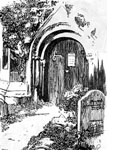
The Carthusian Martyrs of London
"THESE FATHERS GO TO DEATH AS BRIDEGROOMS TO MARRIAGE"
We hear often of Catholics who are unhappy with the Holy Father, both the man and the office. Some have been known to arrogate his authority to themselves in their own bailiwicks, where they have their minor entourages of disgruntled folk who are ambitious to remake the universal Church in their own image and likeness. This visible protest of today is nothing new. Its roots are in the Reformation of the 16th century, and its verbiage and self-righteousness are familiar. It might be good for us to return for a moment to London in the 1530s, when a king whose bedroom misbehavior was the talk of Europe took the lives of 18 men from a religious community because they would not mimic the time-serving clergy of their country and assert that the Vicar of Christ on the Throne of Peter is not the head of the Church.
Carthusian monks had been living just outside the walls of London since their Charterhouse of the Salutation of the Mother of God was founded in the late 1370s to pray for the souls of the thousands of Londoners who had perished in the Black Death plague. The monks were known for their devout rendition of the Liturgy of the Hours and were much sought after for their spiritual counsel and prayers. Fr. John Houghton, a man who had degrees in civil and canon law from Cambridge, was the Prior. Fr. William Exmew, also a Cambridge man, a specialist in Greek and Latin studies, was his assistant. Among the other monks were Fr. Humphrey Middlemore, Fr. James Walworth, Fr. John Rochester, Fr. Thomas Johnson, Fr. Richard Bere, Fr. Sebastian Newdigate, Deacon John Davy, and several lay brothers. All in all, it was a thriving little community filled with talent and holiness, but it was about to run afoul of an ambitious and powerful movement for “reform.”
What started the monks of the Salutation Charterhouse toward their untimely and unjust end was King Henry VIII’s inability to obtain an annulment of his marriage to Catherine of Aragon, to whom he had been wed for twenty years without having a surviving male child to succeed him. Surrounded by clergymen such as Cardinal Wolsey who bent all the bendable rules of the Church in his favor, Henry could not take the Pope’s no as a final answer. Henry had been named “Defender of the Faith” in 1521 by Pope Leo X for his treatise in defense of the seven sacraments. And now the pampered potentate invented for himself a new position and title: “Supreme Head of the Church in England.” Having thumbed his nose at the Pope, Henry obtained from his new Archbishop of Canterbury, Thomas Cranmer (who was not of the same mettle as Lanfranc, Becket, Langton, or Edmund Rich), the divorce he so longed for, and he crowned Anne Boleyn as the new Queen.
Henry now made it law that Anne’s children were to be the successors to the English throne. Even Thomas More could come to accept this as a matter of politics, though he disliked it. But Henry went far beyond the bounds of his competence, summoning Parliament to pass acts putting Church affairs in royal hands and requiring all to swear an oath by God Almighty that Henry was “the only supreme head in earth of the Church in England.” Egged on by the rising and ambitious Thomas Cromwell, a strong advocate of Protestantism, Henry sent royal commissioners out to secure the taking of the oath. In the spring of 1534 the London Carthusians received their visit.
You May Also Enjoy
The Cost of Persistent Chaos... And You Shall Call His Name… Communists Have Feelings Too... Outside the Lines... Unto Dirt You Shall Return... Funny Money... Back to Beer... Beer Black Market... By the Seats of Their Pants... Woolly Schoolmates... and more
Our morally bankrupt political leaders lie for a living and call it the “fact-checked” truth.
Commonweal asks if the Church can "confess" doctrinal errors.

